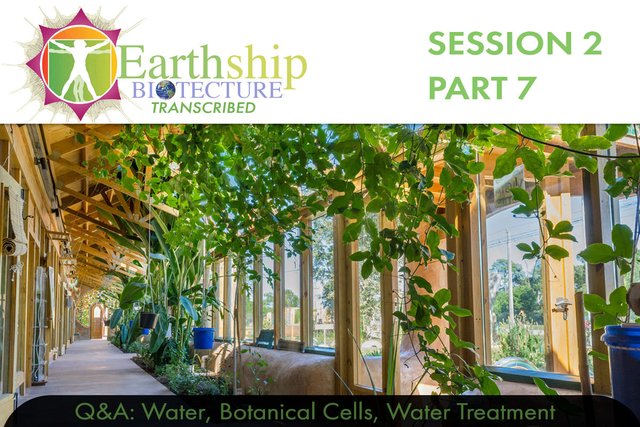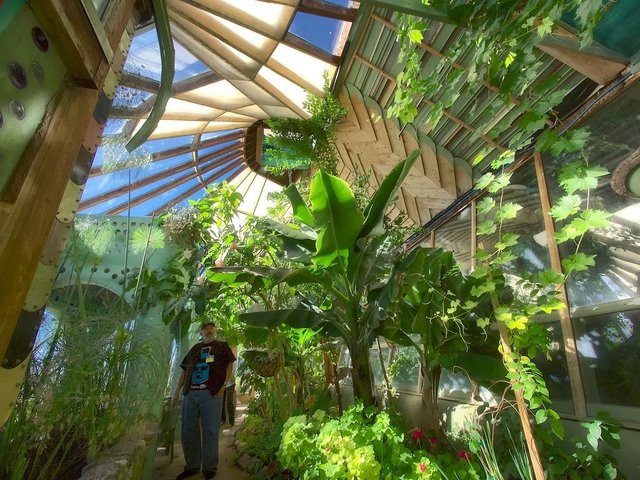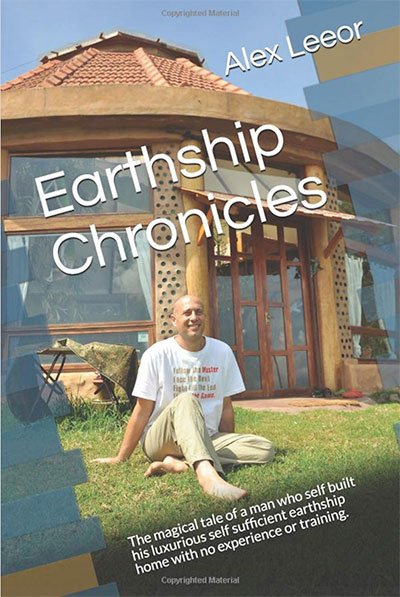Earthship Biotecture Transcribed: Session 2/Part 7: Q&A: Water, Botanical Cells, Water Treatment

I would like to thank Mike Reynolds for giving me permission to transcribe, edit and reformat this work for the Steem Blockchain! If you do read or watch this and have any questions please ask in the comments. I am happy to educate and help you to understand this. Biotecture is amazing in so many ways, and even after 20 years I still have not seen a model of sustainable building that even comes close in so many important areas such as performance, carbon footprint, longevity, ease of build, etc... Now you can also come to understand what Biotecture Really Is about!
Commentary
This is a question and answer session, mainly focussed on the black and grey water planters. Some very important questions come up, including how to start a water treatment planter so that it will be healthy, and produce food and be resistant to bugs. We also look at what plants to use to start a botanical cell and other common questions such as what soaps can be used with it.
Earthship Seminar Transcription Session 2 - Part 7:
So there's all of these safeties set up for it because, we learned that the hard way. Somebody built one, we didn't build it, they took our stuff and books and built one in Colorado. And just to show you how all the systems are interrelated this is a good example. They were in an Earthship an early one that had the early models of all these systems. An old 80 year old guy was staying with him... one of their fathers or something... and took his teeth out. They were going for a picnic or something, he took his teeth out to wash them in the lavatory in the sink and spaced out being 80, and left the faucet running. And the other people, the younger people, didn't notice. They all got in the car and left came back, I think the next day or something, and the sink just stayed running of course, and it drained their cistern into their living room planter... which didn't have an overflow, which flooded their living room... and the pump just kept running and ran down their power.
So in other words they ran down their power down and had water in their living room, all in one teeth cleaning incident. So what we learned there, was and it wasn't us because we didn't build it... but still that was a lawsuit waiting to happen. And so we have everything checked out like, if your water pump stays running too long it turns its own circuit off. If it did for some reason keep running, it would simply go on overflow into the septic overflow into the Botanical cell outside, and overflow on into the outside drain field... and never flood your living room. As a result of that we have every interior Botanical cell with an overflow that goes to everything else. So you're gonna go out there and make mistakes, to tell you how to evolve the system. And we're still doing it, only it's much more minor mistakes now as everything about this does work now... there's not many of those kind of incidents happening these days. So that is the the basic water system.
(Question) How Do you get Your Water Treatment Systems Through Regulations?
They ignore all of it. Most of them just say "look it's gonna be easiest for everybody if we just ignore your system. We are letting you put it in, but we're gonna ignore it including in ours. In other words you're we're basically duplicating a system, but we need the septic tank anyway. So all we're duplicating is a drain field and six or eight hundred dollars for a drain field is lot cheaper than fighting the authorities and trying to prove and whatever.
Question: On these systems at some point is there any repair or replacement to be done, or whats involved in that?
We've never had to do... in a few cases in, the older models, we've had to go in and clean out systems... but not much. The newer models with the plastic systems, they don't even need cleaning out. The old systems had a funkier roof, the filters would get dirty quicker, the cisterns would get dirty quicker. Now the clean metal roofs, the filters need to be cleaned... you know three or four times a year at the most. The cisterns never need cleaning. It's kind of working pretty smooth right right now. All aspects of this whole integrated water system, which again...
Look at the electricity needed by this... that's why we stay away from the the light filters and all of that. It's two pumps, it's two little DC pumps... and those pumps are DC for a reason. We're going to take a break in a minute and then I'm going to do the power conversation, but the the DC pumps are there because... If you take everything, normally electricians and solar designers will tell you... just invert everything to AC and use all AC stuff just like a conventional house. Well then if your inverter ever goes on the blink or fries a circuit or whatever, your whole house is down. What we do is we make the water pumps, which are very cheap and DC, the refrigeration and some lights to be DC... so that if your inverter fries, you still have a life. You can still turn your faucets on, you can still flush your toilet, you can still have ice, and you can still have some light. We only use AC for computers and TVs and things like that and some lamps and appliances, but we make the function of the house bypass the inverter, straight with DC. so that's why there's two little DC pumps... you'll see them, every house has got a water a gray water board it's just a littler version of the of the fresh water board... it's a little green board that has a filter and a pump and a charcoal filter... and if you want to know where it is in each house just flush the toilet you'll hear it humming somewhere, and follow the sound. The fresh water boards are usually in the back hallways. In the Phoenix we always respond to whatever... some people have in fact complained about the the hum sound of the pump when you flush the toilet... So we got them out in the green houses a lot, but at the Phoenix we've even got that sound to disappear... so there's no hum of a pump when you flush the toilet... there is a hum of a pump on the water when it builds up the pressure tank, but it's in a back hallway and you can hardly hear it.
Question: With the black water, is there any code issue with bringing the water back into the greenhouse after treatment?
Not if they don't know it! (laughter), Well what we do is we call it exterior, like what we did at the Phoenix was we did it exterior and then we built a greenhouse over it. So basically you call that greenhouse an exterior greenhouse. It's not part of the house. You're just sheltering the plants from either rain or cold weather, so that they can grow year-round. And so in the worst scenario you may have to move it from the house a little bit, and then it doesn't work as a buffer zone. There is no smell you know. It's all sealed see... that grey water that's in that gravel is sealed by a foot of dirt, and even you can stick your nose down the pipes... we have observation stems everywhere... there's no smell, nope there's just no smell.
So there's people that are paranoid of any aspect of this because of even the transpiration the water that comes up through the plant roots and gets on the leaves.. pathogens and things... they say that could get through. But we've never found it, you know.. In other words, compared to what you face in a city with, you know... give me a pathogen or two... I'll take it any day.
(Question:) Are there certain kinds of soaps that you need to use to wash your body? ..
Nah, you can use anything. The only thing you don't want to do is you don't want to pour photography chemicals or turpentine down your drain, or anything like that... but you can use any of the soaps... and it's it's real easy. It's not some kind of super organic rocket science thing, it's just.. don't put paint thinner down your drain... it's about all you have to remember.
(Question): With the double greenhouse over the blackwater system, have you encountered anything with the humidity with the amount of heat coming into it with the plants.
We like it here in this climate! Yeah you get humidity, we get rid of the humidity as much as we want by ventilation and convection driven ventilation in the greenhouse... but at the Phoenix I like to close it all up, and it's like... and you walk off the dry Mesa into the Phoenix and you're like walking into a rain forest... it's great, so we haven't considered humidity as a problem... but we've experienced it, and humidity is good in this climate. In a a wetter climate you'd want to vent that humidity out, to some extent... at least in the living spaces. Like in a wetter climate you may put all the planting out in the greenhouses and not in the living spaces, so that you can vent them separately and keep your humidity trapped for the plants. So knowing the principles of all this, then you you do have choices of how you're going to set it up... but you know what's going on, and you know the rationale for how to set it up.
(Question:) What about toothpaste... does it build up in the grey water system?
no, it's like soap it breaks down... and plants like all that stuff... they provide nutrients for the plants, they like grey water better than fresh water.
(Question) Are there things that would need to be replaced after say 10 or 20 years?
Well, pumps maybe... the filters. The water filter the way I had it explained to me by the health officials, that's why I started using one is that you never have to replace it... it just gets better. It's organic. It's an organic filter that just keeps getting more and more organic, and becomes a better filter, and a better filter... So it actually reduces the nitrate loading of the water... and when you test the water it does have low nitrate loading.
(Question) Have you had issues with planters getting root-bound in the botanical cells?
Well actually the we haven't dug one up cause of root-bound so the more roots the better it's going to work I mean I've had people build these as per our drawings, say in Colorad...o call me up a couple months later and say, "this thing's not working, it's all saturated"... and I said "well what kind of plants you got in it?", and they said, "well we hadn't planted it yet".. The plants are the system, you know. This isn't just a reservoir to hold water it's a place to hold plants, because plants eat water and so the more roots the better. No root bound issues so far have been seen.
I should mention one last thing real quick and then we'll take a break and then we'll do electricity and then the tour. What you do with these greenhouses, these botanical cells, is you start them with hardy plants that are more bomber and strong, especially with grey water they get even stronger I've got a list of them in the water from the sky book but it's like bananas for sure, bougainvillea, all the geranium family, all the wandering jew family, aloe, philodendron, grapes, all of those kind of plants... all the dew ground covers... they tend not to get bugs anyway and they tend to grow fast they tend to be Hardy. So if you notice that buildings, lots of them, that you're going to see aren't finished... and they're all full of these kind of plants... and because we plant them, the crew tramps on some of them even, but we just want to get the planter established... because it is the sewage system, and we put plants out there just struggling to survive with the crew dragging cords and tools through and everything.
But the plants get in there and get established and you get the whole thing covered with plants, the Jade plants a good one... and that starts the sewage eating process. Then after you got your sewage being eaten after a few months, then you go in and your carve out a little place and you stick in a rose... and the roses do great, but not all by themselves... they like to be surrounded by companion planning or whatever. Tomatoes if you filled your whole greenhouse with Tomatoes, why you'd have white flies. We get plenty of volunteer tomatoes and pot plants in our planters because the crew sits on the planter wall and eat lunch... so we get all these volunteer plants coming up, and then we don't notice it until somebody's in there and whatever... hopefully it's not a state official (laughter). But the you carve out and put in food, then and cantaloupes, and all if you just started the whole thing with food you'd have bugs .
You you must have these strong hardy plants that are resistant to bugs as the basis and then you place the foods and the flowers in between. I've eaten it from the Phoenix I've eaten sweet corn you know. I would go over there at lunch and graze. I eat Tomatoes now I eat tilapia, corn, bananas, grapes, watermelon... everything. I mean I just graze from the Phoenix grocery store. We have a pineapple growing over there... citrus. We have a tangerine tree in the Phoenix, is the biggest one...We got a grapefruit line, we got a fig tree grown in the Phoenix... so you can just grow. We're trying to find out what you can't grow but so far you know everything.
So what we're doing is when you see the Phoenix if you haven't seen it you'll see why it has inspired us to do what we're doing with this eve project. The building you were working on here this yesterday, we're hooking a greenhouse on to this building going across in front of the two tower buildings, across the architects office where you were pounding tires on to the next rental units with. It's going to be a huge Amazon jungle greenhouse to produce food because we seeing that we can survive. You know 25 people can survive here we don't need power, we don't need water, we don't need sewage lines, we don't need grocery stores, we can live, and that is freedom.!


Earthship Seminar Video 2009 - Session 2 -Part 7

READ PREVIOUS TRANSCRIPTS
SESSION 1
Part 1: The Global Model
https://steemit.com/ecotrain/@eco-alex/earthship-biotecture-101-learn-with-michael-reynolds-part-1
Part 2: Staying Cool: The Convection Engine
https://steempeak.com/ecotrain/@eco-alex/earthship-biotecture-transcribed-seminar-with-michael-reynolds-transcribed-part-2
Part 3: The Evolution of the Global Model Earthship:
https://steempeak.com/ecotrain/@eco-alex/earthship-biotecture-transcribed-seminar-with-michael-reynolds-part-3
Part 4: Heating your home with body heat in Norway, about permits in USA and Europe... How to get them fast
https://steempeak.com/ecotrain/@eco-alex/earthship-biotecture-transcribed-pt4-heating-your-home-with-body-heat-in-norway-about-permits-in-usa-and-europe-how-to-get-them
Part 5: How to Retrofit, Getting Permits, Tire Toxicity?
https://steempeak.com/ecotrain/@eco-alex/earthship-biotecture-transcribed-pt-5-how-to-retrofit-getting-permits-tire-toxicity
Part 6: Bottle / Can Walls, Tyre Foundations / Snow Water
https://steempeak.com/ecotrain/@eco-alex/earthship-biotecture-transcribed-pt-6-q-and-a-bottle-can-walls-tyre-foundations-snow-water
Part 7: Can you insure an earthship?, the double/triple greenhouse, the global model evolution + more
https://steempeak.com/ecotrain/@eco-alex/earthship-biotecture-transcribed-pt-7-q-and-a-can-you-insure-an-earthship-the-double-triple-greenhouse-the-global-model
Part 8: Final: Year round fruiting trees, sizing greenhouses + more
https://steempeak.com/ecotrain/@eco-alex/earthship-biotecture-transcribed-pt-8-final-q-and-a-year-round-fruiting-trees-sizing-greenhouses-more
SESSION 2
Part 1: Water, how to size your roof, choosing the right materials for water catchment.
https://steempeak.com/ecotrain/@eco-alex/earthship-biotecture-transcribed-session-2-part-1-water-how-to-size-your-roof-choosing-the-right-materials-for-water-catchment
Part 2: Cisterns, Filtering Water, Designing Down & Layered Thinking.
https://steempeak.com/ecotrain/@eco-alex/earthship-biotecture-transcribed-session-2-part-2-cisterns-filtering-water-designing-down-and-layered-thinking
Part 3: Water! Be Self Sufficient Secure & Sustainable.
https://steempeak.com/ecotrain/@eco-alex/earthship-biotecture-transcribed-session-2-part-3-water-be-self-sufficient-secure-and-sustainable
Part 4: Botanical Cells, Using Water 4 Times, Food Production.
https://steempeak.com/ecotrain/@eco-alex/earthship-biotecture-transcribed-session-2-part-4-botanical-cells-using-water-4-times-food-production
Part 5 : The Solar Toilet, Making Mistakes and Evolving is Part of the Process.
https://steempeak.com/ecotrain/@eco-alex/earthship-biotecture-transcribed-session-2-part-5-the-solar-toilet-making-mistakes-and-evolving-is-part-of-the-process
Part 6: Black Water Treatment In Any Climate, Food Production.
https://steempeak.com/ecotrain/@eco-alex/earthship-biotecture-transcribed-session-2-part6-black-water-treatment-in-any-climate-food-production

Did you know, I built four Earthships in India as well as being instrumental the creation of the first Earthship in the UK, Earthship Brighton. If you are also on this path and would like to read my story, I have recently published a book. It is not only a great story, but a valuable resource for you to learn from. I had no experience or training when I embarked on my mission, but managed to successfully build a gorgeous home called Earthship Karuna.
You can buy this book with Steem on the homesteaders co-op. Whilst you are there please do have a look at some of the other products as there are all kinds of great things there!


https://homesteaderscoop.com/product/earthship-chronicles-ebook/
If you don't have any Steem you can also buy the ebook and paperback on amazon.
http://mybook.to/Earthship-Chronicles
or
https://www.amazon.com/Earthship-Chronicles-sufficient-luxurious-experience-ebook/dp/B07MYCBXYB
@ecoTrain
Supporting People Who Help
Make The World A Better Place

Discover previous ecoTrain magazines at @ecoTrain
** Click Here To View Our Passenger Feed**


That form of mixed planting really sings to my soul - the rose next to the lime tree which is next to the tomatoes, the basil and some amazing spathophylla and philodendrons. That the garden is also part of the waste management and oxygen production process? Wow. Just wow. Gratitude for your perseverance in making this epic available to all - you are rivaling Game of Thrones in epicness, methinks. LOL.... x
Leading the curation trail for both @ecotrain & @eco-alex.
Together We’re Making This World A Better Place.
Click Here To Join the manually curated trail "@artemislives" to support quality eco-green content.
@ecoTrain